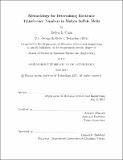| dc.contributor.advisor | Antoine Allanore. | en_US |
| dc.contributor.author | Cann, Jaclyn L | en_US |
| dc.contributor.other | Massachusetts Institute of Technology. Department of Materials Science and Engineering. | en_US |
| dc.date.accessioned | 2017-09-15T14:20:08Z | |
| dc.date.available | 2017-09-15T14:20:08Z | |
| dc.date.copyright | 2017 | en_US |
| dc.date.issued | 2017 | en_US |
| dc.identifier.uri | http://hdl.handle.net/1721.1/111225 | |
| dc.description | Thesis: S.M., Massachusetts Institute of Technology, Department of Materials Science and Engineering, 2017. | en_US |
| dc.description | This electronic version was submitted by the student author. The certified thesis is available in the Institute Archives and Special Collections. | en_US |
| dc.description | Cataloged from student-submitted PDF version of thesis. | en_US |
| dc.description | Includes bibliographical references (pages 91-93). | en_US |
| dc.description.abstract | Electrolysis of molten copper (I) sulfide (Cu2S) in a sulfide-based electrolyte is being investigated for use as a direct path for copper extraction to replace the conventional process of smelting and electrorefining [1]. The allure of an electrolysis process for metals extraction can be enhanced by increasing its faradaic efficiency, through, for example, decreasing the electronic transference number of the electrolyte. This thesis compares two methods of determining the electronic transference number in Cu2S - barium sulfide (BaS) electrolytes to determine whether one or both methods are wellsuited for use with these high-temperature electrolytes. The first method is a stepped potential chronoamperometry method, in which the electronic transference number is determined from the decay of the current after a voltage step. The second method is a faradaic efficiency method, where the ionic transference number is determined from the efficiency with which ions can be transported from one electrode to the other. The stepped potential chronoamperometry method estimates electronic transference numbers between 0.73 and 0.85, while the faradaic efficiency method estimates values between 0.12 and 0.34 for the same electrolyte. Three differences between the experiments are investigated: (1) the work functions of the electrodes used, (2) the additional alloying driving force in faradaic efficiency experiments, and (3) the tin impurities in the electrolyte. This analysis suggests that the difference between the work function of the electrode and the electron affinity of the electrolyte may be the dominant cause of the experimental discrepancy. Therefore, it is suggested that electrodes and electrolytes be chosen to maximize this difference to enhance the faradaic efficiency of copper extraction from Cu2S. The underlying physics of semiconductiviy in molten sulfides, however, remains unclear. Future study of the electronic structure and short range ordering of molten metal sulfides to better understand and predict electronic properties is needed. | en_US |
| dc.description.statementofresponsibility | by Jaclyn L. Cann. | en_US |
| dc.format.extent | 93 pages | en_US |
| dc.language.iso | eng | en_US |
| dc.publisher | Massachusetts Institute of Technology | en_US |
| dc.rights | MIT theses are protected by copyright. They may be viewed, downloaded, or printed from this source but further reproduction or distribution in any format is prohibited without written permission. | en_US |
| dc.rights.uri | http://dspace.mit.edu/handle/1721.1/7582 | en_US |
| dc.subject | Materials Science and Engineering. | en_US |
| dc.title | Methodology for determining electronic transference numbers in molten sulfide melts | en_US |
| dc.type | Thesis | en_US |
| dc.description.degree | S.M. | en_US |
| dc.contributor.department | Massachusetts Institute of Technology. Department of Materials Science and Engineering | |
| dc.identifier.oclc | 1003283962 | en_US |
